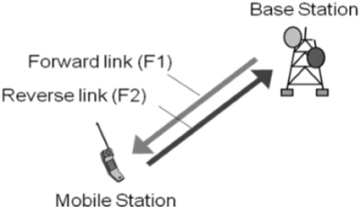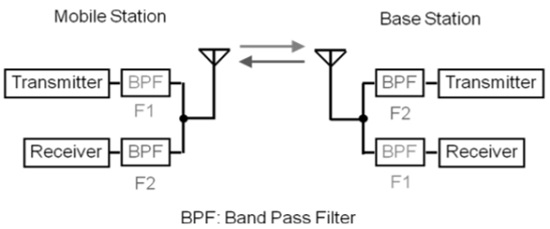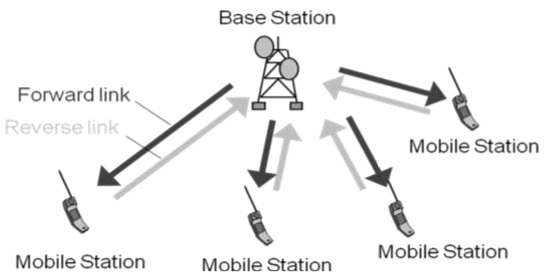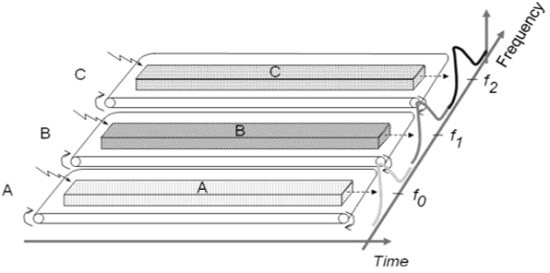In Frequency Division Duplex (FDD), the forward link frequency is not the same as the reverse link frequency. In each link, signals are continuously transmitted in parallel.

Example of FDD System
FDD requires two symmetrical segments of spectrum for the uplink and downlink channels.
In a cell phone with a transmitter and receiver, operating simultaneously in such close proximity, the receiver has to filter as much of the signal from the transmitter as possible. More separation of the spectrum, the most effective filters.

FDD uses a lot of frequency spectrum, generally twice of the required TDD spectrum. In addition, there must be adequate spectrum separation between transmission and reception of the channels. These bands keep saying − it cannot be used, they are unnecessary. Given the scarcity and cost of the spectrum, they are real disadvantages.
Use of FDD
FDD is widely used in different cellular telephone systems. In some systems, the band 869-894 MHz is used as the downlink (DL) spectrum from the cell site tower to the device. And, the band 824-849 MHz is used as the uplink (UL) spectrum of the handset at the cell site.
FDD also works on a cable where transmit and receive channels are given different parts of the cable spectrum, as in cable TV systems. And, filters are used to keep the channels separate.
Disadvantage of FDD
The drawback of FDD is that it does not allow special techniques like multiple antennas, multiple input-output (MIMO), and beamforming. These technologies are an essential element of the new strategies Long Term Evolution (LTE) 4G cell phone to increase the data rate. It is difficult to make broad enough bandwidth to cover both sets of antenna spectrum. Circuit complex dynamic adjustment is required.
Multiple Access Methods
The radio channel is a communication medium shared by several users in a geographic area. Mobile stations are in competition with one another for the frequency resource to transmit their information flow. Without other measures to control concurrent access of several users, collisions can occur. Since collisions are undesirable for connectionoriented communication such as mobile phones, personal/mobile subscriber stations need to be allocated the dedicated channels on request.

The mobile communication, sharing wireless resources on all users, must be communicated to identify the user. While identifying the user, it is referred to as "multiple access" (Multiple Access) that is receiving a radio wave of a number of transmitting stations in a receiving station (as shown in the following image).
FDMA - Technology
Frequency Division Multiple Access (FDMA) is one of the most common analogue multiple access methods. The frequency band is divided into channels of equal bandwidth so that each conversation is carried on a different frequency (as shown in the figure below).
FDMA Overview
In FDMA method, guard bands are used between the adjacent signal spectra to minimize crosstalk between the channels. A specific frequency band is given to one person, and it will received by identifying each of the frequency on the receiving end. It is often used in the first generation of analog mobile phone.

Advantages of FDMA
As FDMA systems use low bit rates (large symbol time) compared to average delay spread, it offers the following advantages −
- Reduces the bit rate information and the use of efficient numerical codes increases the capacity.
- It reduces the cost and lowers the inter symbol interference (ISI)
- Equalization is not necessary.
- An FDMA system can be easily implemented. A system can be configured so that the improvements in terms of speech encoder and bit rate reduction may be easily incorporated.
- Since the transmission is continuous, less number of bits are required for synchronization and framing.
Disadvantages of FDMA
Although FDMA offers several advantages, it has a few drawbacks as well, which are listed below −
- It does not differ significantly from analog systems; improving the capacity depends on the signal-to-interference reduction, or a signal-to-noise ratio (SNR).
- The maximum flow rate per channel is fixed and small.
- Guard bands lead to a waste of capacity.
- Hardware implies narrowband filters, which cannot be realized in VLSI and therefore increases the cost.